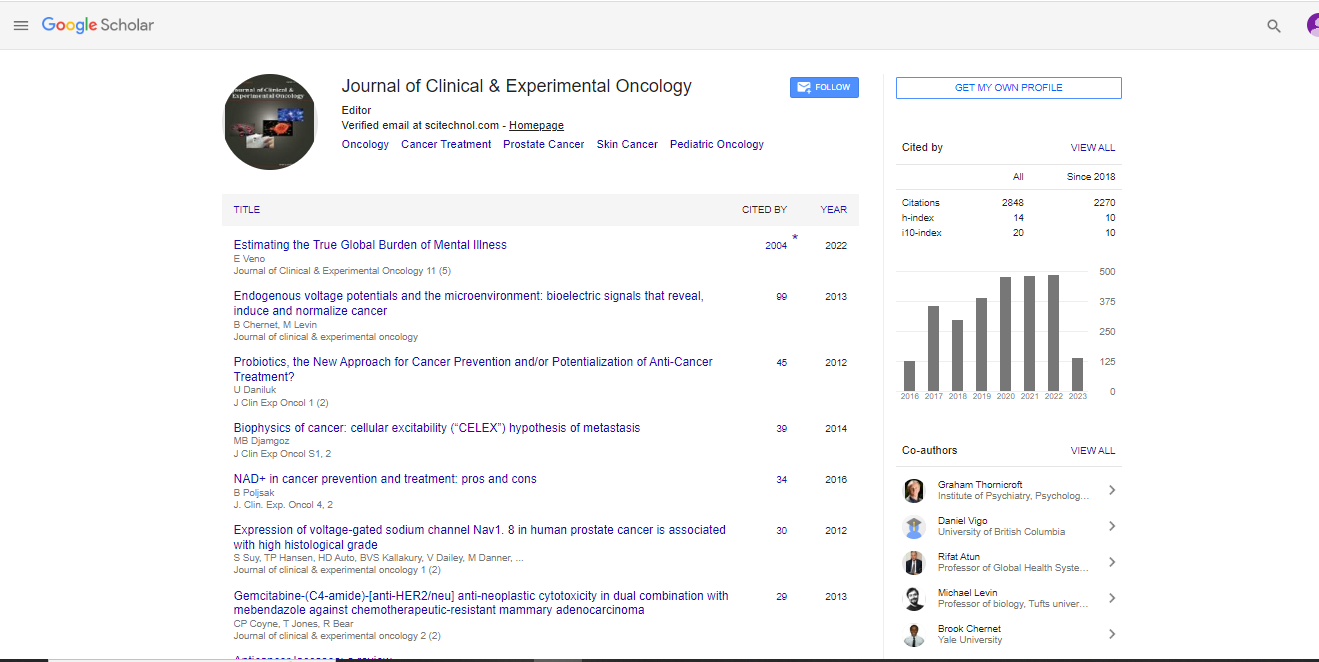Opinion Article, J Clin Exp Oncol Vol: 13 Issue: 6
Epidemiological Patterns and Risk Factors of Colorectal Cancer
Hanoma Takenshoi*
1Department of Colorectal Surgery, National Cancer Center Hospital, Tokyo, Japan
*Corresponding Author: Hanoma Takenshoi,
Department of Colorectal Surgery, National Cancer Center Hospital, Tokyo, Japan
E-mail: hanomacs@ncch22.jp
Received date: 27 November, 2024, Manuscript No. JCEOG-24-156852;
Editor assigned date: 29 November, 2024, PreQC No. JCEOG-24-156852 (PQ);
Reviewed date: 13 December, 2024, QC No. JCEOG-24-156852;
Revised date: 20 December, 2024, Manuscript No. JCEOG-24-156852 (R);
Published date: 27 December, 2024, DOI: 10.4172/2324-9110.1000442.
Citation: Takenshoi H (2024) Epidemiological Patterns and Risk Factors of Colorectal Cancer. J Clin Exp Oncol 13:6.
Description
Colorectal cancer (CRC), which includes cancers of the colon and rectum, is one of the most common malignancies globally. It represents a significant public health issue due to its high incidence, mortality rates and preventable nature. Understanding the epidemiological patterns and risk factors of colorectal cancer is essential for developing effective prevention strategies and improving early detection. The highest incidence rates of CRC are seen in regions such as North America, Europe and Australia, while the lowest rates are reported in parts of Africa and South-Central Asia. These variations are primarily attributed to differences in dietary habits, lifestyle factors, healthcare infrastructure and screening practices. Notably, the incidence of CRC is rising in many Low-and Middle- Income Countries (LMICs) due to increasing urbanization, dietary changes and reduced physical activity.
CRC predominantly affects older adults, with the majority of cases occurring in individuals aged 50 and above. However, there has been a concerning rise in CRC incidence among younger adults in recent years, particularly in high-income countries. Men are generally at a slightly higher risk of developing CRC than women, although the reasons for this difference remain unclear and may involve hormonal, genetic and lifestyle factors. Diets rich in red and processed meats are strongly associated with an increased risk of CRC. Cooking methods that produce carcinogenic compounds, such as grilling or frying further increase this risk. Diets low in fruits, vegetables and whole grains contribute to CRC risk by reducing dietary fiber, which promotes healthy digestion and reduces exposure of the colon to carcinogens.
Obesity is a well-established risk factor for CRC, particularly for colon cancer. Excess body fat promotes chronic inflammation and changes hormone levels, which may contribute to cancer development. Sedentary behavior and lack of physical activity further increase CRC risk by impairing metabolic function and slowing intestinal transit. Heavy alcohol consumption is linked to an elevated risk of CRC. Alcohol metabolism produces acetaldehyde, a carcinogenic compound that damages DNA. Tobacco use contributes to CRC risk through the introduction of carcinogens that affect the colon and rectum. Having a first-degree relative with CRC significantly increases one’s risk of developing the disease. Familial risk accounts for approximately 20% of CRC cases. Genetic conditions such as Lynch syndrome and Familial Adenomatous Polyposis (FAP) are strongly associated with CRC and often result in earlier onset of the disease.
Chronic inflammatory conditions of the colon, such as ulcerative colitis and Crohn’s disease, are major risk factors for CRC. Prolonged inflammation damages the intestinal lining, increasing the likelihood of malignant transformation. The risk of CRC increases with age, with the majority of cases occurring in individuals aged 50 or older. Estrogen may have a protective effect against CRC, which partially explains the lower risk in premenopausal women compared to men of the same age. Access to healthcare, screening programs and education about healthy lifestyle choices significantly influence CRC risk. Populations in low-resource environments often experience delayed diagnoses and poorer outcomes.
Conclusion
Colorectal cancer is a major global health challenge, with significant regional and demographic variations in its incidence and outcomes. By identifying its risk factors, public health initiatives can play an important role in reducing the burden of CRC. Continued studies, equitable access to screening and treatment and lifestyle modifications are essential to reducing the impact of this preventable disease and improving the quality of life for patients worldwide.
 Spanish
Spanish  Chinese
Chinese  Russian
Russian  German
German  French
French  Japanese
Japanese  Portuguese
Portuguese  Hindi
Hindi 



